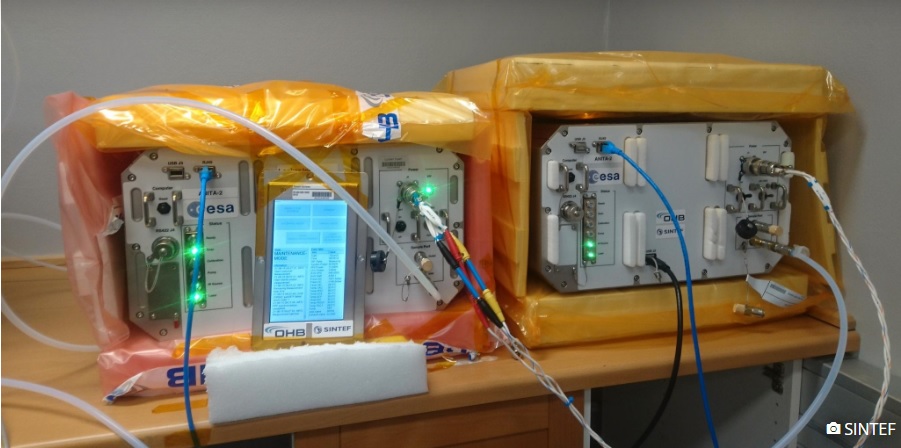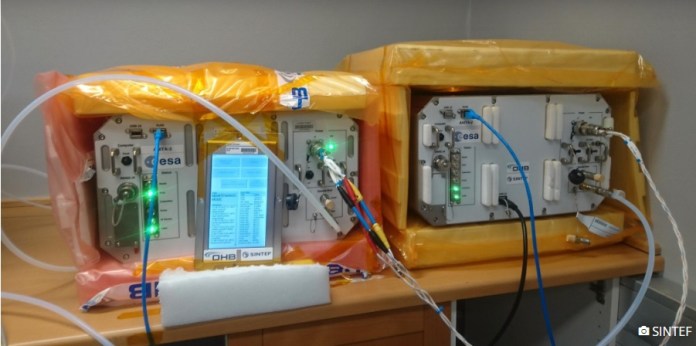
Norwegian Gas Meter Send to International Space Station (Image Credit: SNN)
ANITA-2 has been developed by SINTEF in collaboration with ESA and OHB, and supported by the Norwegian Space Center. By Berit Ellingsen OSLO, Norway —
ANITA-2 has been developed by SINTEF in collaboration with ESA and OHB, and supported by the Norwegian Space Center.
By Berit Ellingsen
OSLO, Norway — At the International Space Station, it is not just a matter of opening a window if astronauts suspect the leak of one of the many gases used on board.
Here the air consists of the same gases as on earth: nitrogen, oxygen, water vapor, carbon dioxide, and other gases in small amounts. But both people, interior and equipment emit different trace gases. Several different types of spacecraft carry supplies and experiments to the space station, and they can also be a source of gases.
Therefore, a gas meter is needed that can analyze the air directly, preferably in real time and be able to tell when it is measuring gases that are dangerous. Like all other instruments to be launched, the gas meter must be relatively small, light and require little power. It is also very advantageous if the gas meter can detect unexpected gases, and if the calibration can be updated from the ground.
Precisely these properties had the gas meter Analyzing Interferometer for Ambient Air (ANITA), which measured 33 different gases in the air at the space station for 11 months from 2007 to 2008.
Now the sequel, ANITA-2, is ready to be launched to the space station (See picture at the top of the article). It happened on December 21, 2021 with a Dragon vessel from SpaceX.
Measures more gases and is smaller and lighter
There are already gas meters on the space station, but ANITA-2 has a high sensitivity to several gases and can follow their development more accurately. ANITA-2 can distinguish between 37 different gases, several of which are life-threatening for humans.
“For each gas, ANITA-2 has one maximum limit for warning of caution and one for warning the gases,” says Atle Honne, senior researcher at SINTEF Digital and head of the development of ANITA-2 in Norway.
If a gas exceeds these limits, the system notifies.
“The special precision of the gas measurements from ANITA-2 also makes it possible to closely monitor whether the concentration is constant or rising or falling, which is very important for the follow-up of the situation,” says Honne.
Even small gas leaks and gas development, for example from a fire, can be detected early and followed closely.
The German-Norwegian gas meter uses infrared technology and innovative software for calibration and analysis specially developed by SINTEF.
“It ensures detailed and continuous information about the air quality in near-real time, with high sensitivity and accuracy,” says Honne.
The air samples are taken inside the space station, need no pre-treatment and are released unchanged back to the indoor air. Thus, ANITA-2 has no other consumption than electricity and does not emit any waste products itself.
“The new gas meter is also significantly smaller and lighter than the first ANITA version, has an expanded analysis program and is operated using a built-in computer with a screen,” says Honne.
Also relevant for the moon and Mars
ANITA-2 is now on its way to the space station in orbit around the earth, where it will measure the gases until further notice, perhaps for several years to come.
Similar technology will also be needed aboard the Gateway, the planned space station in orbit around the moon, to be built by the new lunar missions in the Artemis program. The same applies to spacecraft and bases down on the moon’s surface and on Mars.
“On Earth, gas meters such as ANITA-2 will be useful in all types of closed environments, such as submarines and diving operations, and where the working environment must be closely monitored, such as laboratories, hospitals and industry, as well as monitoring emissions to the environment,” says Honne.
He is looking forward to the launch of ANITA-2 with great excitement. According to the plan, the new gas meter will be installed at the space station on 5 January 2022.
Developed with support from the Norwegian Space Center
ANITA-2 has been developed by SINTEF in collaboration with the European Space Agency ESA and the German industrial giant OHB, with support from the Norwegian Space Center.
“The Norwegian Space Center supports Norwegian technology and experiments that are so far advanced that they are tested on the space station, and the environment at SINTEF around ANITA-2 is at the forefront of its field,” says Arvid Bertheau Johannessen, head of manned spaceflight and exploration at the Norwegian Space Center .
He thinks it is very exciting that a new generation of gas meters is being launched, which Norway has been involved in developing.
“There is clearly a demand for such technology in space, not least when there are now plans for new manned spaceflights to the moon, and in the longer term also to Mars. The development of ANITA-2 is therefore part of a longer race to get Norwegian technology into these large future projects,” says Johannessen.
You can read more about the Norwegian Space Center’s support schemes here .









